What is revitalizant for your car? Consider it medicine. If your car is “ill” with noise, smoking, overconsumption of oil or fuel, decrease of power and compression level, the revitalizant will “heal” it.
Revitalizant also works as a preventive agent, so your car does not get “ill” at all. Treatment of car parts will protect your car from serious problems in the future.
After the XADO Chemical Group had introduced the term “revitalization” into use, the medical and cosmetic companies working on rejuvenation and struggle with ageing have started to use it widely.
After-effect
Once the new coating is formed as a result of revitalization, it retains its unique properties regardless of the revitalizant’s presence or absence in the lubricant.
The unique restoring and rejuvenation properties of the coating can be seen from the following test. A scratch on the working surface is still healed even after 10 oil changes, when each oil change equals a run of 10,000 km (6,200 miles). Such a fantastic after-effect is due to the restoring properties of the coating, and the gained potential of contracting inner stresses.
1. What is the thickness of the metal-ceramic coating formed as a result of revitalization?
The unique quality of the revitalizant is that we are not talking just about atomic layers, but about real microns in the pump element, several hundredths of one millimetre in the engine cylinder-piston group and several tenths – on the reducer gears.
2. Is there a risk of metal-ceramic layer growing in excess? Can it cause the engine to seize up?
No, the engine will not seize up. Revitalization is a self-regulating process, where the friction of surfaces is the necessary condition for it. When the coating is formed, the friction is reduced drastically and the growth of the surface stops.
3. A superhard coating is formed as a result of the revitalizant’s application. Can the engine be rebored, if necessary?
This is a common question from car owners, and we would like to set their minds at ease. The metal-ceramic coating is formed to the depth of 10–30 microns, and the boring tool can remove tenths of a 1 mm. Also, the traditional major engine overhaul can become unnecessary altogether; the revitalizant’s exceptional ability to restore the original shape of worn parts allows car owners to avoid tedious and expensive repairs.
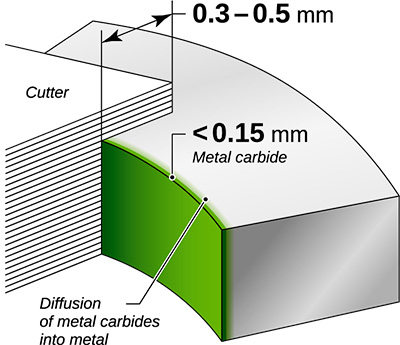
4. What if the metal-ceramic layer peels off in operation?
It is not possible for the metal-ceramic layer to peel off in operation. A reciprocal diffusion of metal and metal carbides to the depth of 10–30 μm (micrometer) takes place. There is no distinct border between the initial surfaces and metalceramic, so there are no conditions for the metal-ceramic layer to “peel-off”.
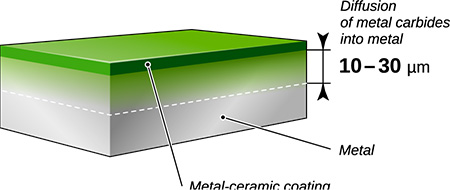
5. I’ve heard that aftermarket additives are clogging up filters...
No. The revitalizant-gel easily dissolves in oil leaving its viscosity and other physicochemical properties unchanged. It easily goes through the filter elements directly to the working friction surfaces.
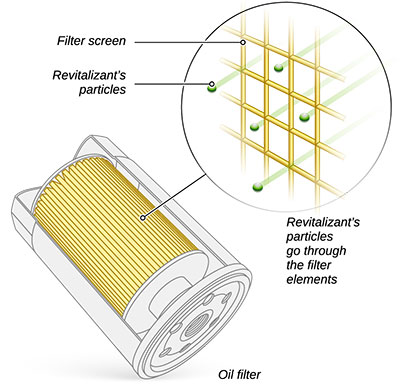
6. I am going to apply revitalizant to my new car, but it is under the warranty…
We stick to the emphatic opinion that it is best to apply the revitalizant compound to the engine during the breaking- in period. The application of the revitalizant is especially efficient when engine parts are new. Due to the revitalizant effect the breaking-in goes quicker, softer, more efficiently and almost without losses of metal into “boring”.
7. What is implied under the protection guarantee for 100,000 km (62,000 miles) of run?
It is implied that the surfaces will not wear out during the guarantee term provided the car is operated in a regular mode. For example, should a scratch appear on the cylinder wall on the 99th (61th) thousand of the run, it would disappear due to the revitalizant’s high restoring properties. The scratch will “heal!”
8. When is it best to start the application of the revitalizant?
Revitalizant is effective at any stage of car operation and is always useful. The most important thing is that the unit must be in an operative state. Ideally, the revitalizant should be applied from the breaking-in period on.
9. What happens to the honing by revitalizant’s application?
Honing is designed to provide relatively safe adjustment of parts and to hold oil on the cylinder walls.
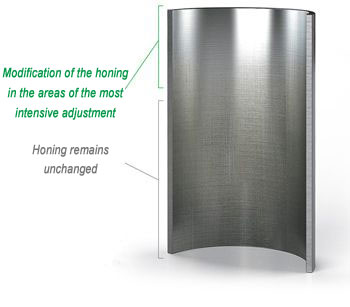
The revitalizant modifies honing in the areas of the most intensive adjustment (cylinder-piston group near the top dead point) and preserves it unchanged in the unloaded zones.
10. Can I drive without oil if I use revitalizant?
No. Driving without oil is only a spectacular test that demonstrates the unique properties of the metal-ceramic coating. The revitalizant has not been designed for driving without oil; only for the increase of the operational life and reliability of car parts.
Oil is not just a lubricant. It also washes, cools, works as a hydraulic fluid by operation of hydraulic lifters, and provides other functions. Oil is necessary even for the car that has undergone the full revitalization cycle. However, under extreme conditions such as loss of oil or driving with a perforated housing, the revitalizant will provide reliable protection for your car.
11. How long does the revitalizant’s effect last?
Tests show that the protective coating remains even after 100,000 km (62,000 miles) of run. After 100,000 km (62,000 miles) it is advisable to repeat the revitalization cycle. To support the surface restoring potential at the highest level it is strongly recommended to use oil with the atomic revitalizant XADO Atomic Oil or Atomic Metal Conditioners (AMC) with revitalizant after each oil change.
12. What kind of oil is the best for treatment: old or new, synthetic or mineral?
It makes no difference because the revitalizant is compatible with any type of oil. It does not chemically react with them and does not change their viscosity, physicochemical or operational properties. The oil only carries the revitalizant to the friction surfaces.
13. I am the second owner; I have no idea what kind of oil was used in the engine. Can I use XADO products?
Even if some additives have been applied to the engine earlier, they will not cause much effect on the revitalizants’ action.
14. Won’t the additive settle in the bottom of the oil pan and lose its efficiency if the car is not used for a long period of time?
No, the revitalizant will not settle. After the revitalizant’s application, the engine should idle from 2 to 5 minutes. At this time the revitalizant will completely dissolve in oil, even if the mechanism has not been used for a long period of time.
15. While idling, the oil pressure indicator blinks. Will the revitalizant help?
There are many reasons for reduced oil pressure, ranging from a failure of the sensor to serious wear of the oil pump, bushings or crankshaft journals. If the wear is not complete, the revitalizant will help.
16. Will the revitalizant help in case of increased oil consumption?
There are still more reasons for increased oil consumption, such as wear of parts in the cylinder or -piston group, bedding, gumming-up or breakage of the piston rings, valve stem seal failure, or oil-leaking through seals. If the reason is wear, the revitalizant will help.
17. How can fuel economy be reached?
For cars with high mileage, the fuel economy is first reached by the engine’s wear compensation and reconditioning of its operating parameters to their default values. On a new engine, the optimization of the interfacings and reduction of friction losses will help you cut down the expenses down the road.
18. While undergoing maintenance, there is a high measurement of toxicity in exhaust gases in my car. Will the revitalizant help?
Increased emissions of harmful substances into the atmosphere could be due to the quality of the fuel used, adjustment and operation of the fuel outfit. The most frequent reason for harmful emissions is engine wear. In this case, the revitalizant will definitely help. The application of revitalizant reduces the emission index by ten times and some parameters by a hundred times.
19. How will I feel the effect of the revitalizant on my car?
The driver will feels an increase in engine power, acceleration, flexibility and change in the sound of the engine operating in different modes. Drivers will notice improvements after a 50–100 km (31–62 miles) run from the product’s application.
These improvements are the result of the revitalizant’s restoring effect, as it increases and equalizes compression in cylinders.
20. Will revitalization help any engine?
Yes, all kinds of engines can be improved with revitalization, as long as the engine is operative. Whether the engine is gasoline, liquefied petroleum gas (LPG), diesel, biofuel, along with high-powered ones, with direct injection, multivalve, or equipped with turbo-charger, revitalization will help.
In order for the protective metal-ceramic coating to be formed, the engine must be in an operable state.
The check parameters, which can measure the engine’s operating capacity, are compression and fuel consumption. The decrease of compression for 20–25% – from the nominal parameters, its dispersion on cylinders by more than 1.5 unit (atm) and/or the oil consumption more than 0.4–0.6% from the fuel consumption can indicate the critical condition of an engine.
Examples of the critical condition of an engine:
1. The rated value of the compression in the engine is 14 units (atm). The value of the compression in one of cylinders is 10,5 and less units (atm) or the compression is 11 and 13 units (atm).
2. The fuel consumption in the engine is 10 l for 100 km (1 gal for 25 miles), with oil consumption of 800 ml for 1000 km (1 US qts for 750 miles) and more.
Critical condition of an engine is indicated by 100% wear of its parts (parts are damaged)
The revitalizant shows its restoring effect even when the engine is in critical condition. However, in this case, the full restoration of the engine’s operational parameters to original values may not occur.
21. When is it recommended to use the revitalizant for cylinders? Is there a revitalizant to treat the whole engine?
Gel revitalizant for cylinders is designed to treat working surfaces and is applied directly onto the cylinder walls to remove shape defects such as ellipse form and scorings and scratches up to 0.1 mm.
Service stations have found revitalizing useful even for complete engine overhauls. Prior to the final engine assembly, the cylinder-piston group and crankshaft bearings of the gas distribution mechanism are lubricated with a mixture of gel revitalizant for cylinders and oil in equal parts. This guarantees their effective bedding-in, eliminates inaccuracy of the reconditioning and considerably increases the engine’s service life.
22. Should the treatment of the diesel engine and fuel outfits be done separately or simultaneously?
It is better to do it simultaneously. The simultaneous treatment not only improves the engine operation by increasing its power, but it also improves the performance of the fuel outfits. The fuel pressure increases and the fuel-injection improves, which results in greater fuel economy.
23. Does the revitalizant damage the turbine?
No, the revitalizant protects the turbine and extends its operation life. The turbine is designed in such a way that its journal bearings are lubricated with a relatively thick oil coating, hydrodynamic lubrication mode, in practically all operational modes. The main wear of a bearing occurs at start and stop, when this coating is disturbed. The revitalizant comes into full action exactly during this moment of highest wear for the turbine moment, forming a protective coating on the bearings.
24. I have the “Common Rail” injection system, diesel engine CRDi. Has revitalizant been tested for use in these engines?
Yes, it has been tested, and regularly undergoes testing for new constructive innovations. Modern systems of diesel engine fuel lines with the high-pressure generation, such as “Common Rail” and “Pumpe-Düse” (pump-injector) types, have plunger pumps where the plunger and sleeve wear the most. There are no technical restrictions in applying revitalizants to these fuel supply systems. The coating formed on the plunger’s surface provides protection for the complex mechanism from low-quality fuel, that can contain mechanical fouling or water, and from fuel with bad lubricating properties. This includes nonsulfurous fuel, or “dry solar oil”, biofuel with a high ethanol concentration.
25. If the box is droning, will the revitalizant help?
There are two main reasons for the increased noise from transmission mechanisms. Droning can occur gradually, as it is connected with the wear of gear teeth, bearings and shafts. The revitalizant always helps in such instances. However, sometimes the box drones from the beginning of its operation as a result of production deficiency, causing problems in the gear teeth changeover or causing the teeth to come together too tightly. The revitalizant will work in this case too, but if the deficiencies are substantial, the noise may not disappear.
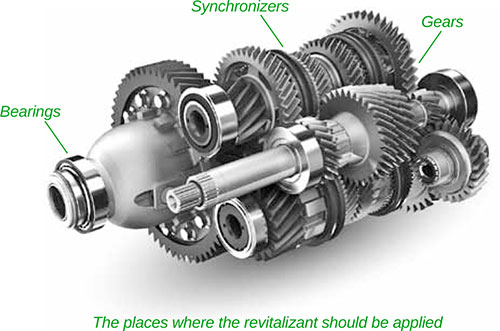
26. How can gear shifting precision be improved?
The Gear shifting provision can be improved with a new coating formation. The distinguishing feature of the revitalizant is to form a protective coating not only on the ferrous materials, but on the nonferrous metals as well. This is especially evident on the synchronizers, which are manufactured from bronze alloys, or nonferrous metals, and are responsible for gear shifting.
27. What gel should be used when modern robotized gearboxes stand between the mechanical and automatic gearboxes?
Robotized gearboxes and gearboxes with dual clutch, or dual clutch transmission, are improved automatic gearboxes. For the revitalization, it is recommended to use the gel for the gearboxes and reducers.
28. What should be applied for the mechanical gearbox with the liquid for the automatic gearboxes?
In modern mechanical gearboxes, where liquid for automatic gearboxes (ATF) is used, it is recommended to use the gel for the gearboxes and reducers.
29. Will the revitalizant harm the performance of friction clutches in self-locking differentials?
No, it won’t. The revitalizant can be used without any hesitation in axles with self-locking differentials. The assembly is designed in such a way that the torque transfer of the friction clutches occurs through the oil and depends on its viscosity. The revitalizant has no effect on the viscosity properties of oil.
30. The automatic gearboxes (CVT) with the V-belt variable speed drive unit differ in their capriciousness. Will the revitalizant help?
Yes, it will. The weak point of the variable speed drive units is the contact of the wedge-like surface of the belt with the pulley, and it is this contact that is effectively protected by the revitalizant. The revitalizant also protects other metal parts such as gears, bearings and couplings.
31. My scooter has separate oiling system. Where should I squeeze the gel – in the oil or in fuel?
A special gel is manufactured for the motorcycling vehicles. During the treatment of the four-cycle internal combustion engine, the revitalizant is applied directly to the oiling system of an engine.
Scooters with two-cycle engines can have separate and mixed oiling system.
During the treatment of the two-cycle engine with the separate oiling system, the revitalizant is added into the oil tank of the scooter. In scooters with a mixed oiling system the revitalizant, after first being dissolved in the small amount of the oil, is applied directly to the fuel tank.
32. The bearing is droning. What kind of revitalizant should be applied?
Along with the gel revitalizants, XADO manufactures lubricant greases. In order to choose the correct grease, it is necessary to determine the wear rate of the unzit.
The Protective grease is applied to the new units and units with insignificant wear, or wear up to 10%, and it is a multipurpose substitution for any lubricant grease.
The PRestoring grease contains more active components. That is why it not only protects the surface of the part, but also restores its original shape. It is applied to units and mechanisms that have up to 50 % of wear.
The Repairing grease is applied to the units with the wear of up to 80%.
You can also choose the suitable packaging – tube, cartridge or container, and the amount of grease needed.

33. What is the difference between the 1 Stage revitalizant and the usual engine gel?
Today, the 1 Stage is one of the most powerful products in the revitalizant line. The advantages and differences from the usual engine gel are the operating speed, high-speed surface modification, the universality of the application and the one-phase treatment..
Operating speed. The new, perfect formula of the compound makes it possible to fully restore and perfectly protect the engine after a 100 km (62 miles) run, and guarantees its absolute protection from wear for 100,000 km (62,000 miles).
Universality. The compound is ideally suited for gasoline and diesel engines of any construction and uprating grade. The product is universal in respect to any state of the engine’s wear. It is also suitable for cars with high mileage as well as new cars.
One phase treatment. The revitalization is carried out in one phase. It saves time and makes the treatment procedure much easier.
1 Stage is the perfect choice for the consumer who appreciates a quick and reliable result.
34. What should I choose for the treatment: the package with 3 tubes, 1 Stage revitalizant or Metal Conditioner Maximum with the revitalizant?
Every product has its advantages.
The classical engine revitalizant package with 3 tubes is priced well and offers a 3-stage application process in one purchase.
The comfort one-phase treatment yields a quick result and universality regardless of the engine type. Its mileage capability is an obvious advantage of the 1 Stage product.
The Atomic Metal Conditioner, in addition to its revitalization properties, sets itself apart with an extra-strength greasing film and the ability to drastically improve the lubricating properties of the oil. All of these revitalizant products restore and protect the engine.
35. Doesn’t good synthetic oil already contains all necessary additives?
Manufacturers tend to minimize their costs and make the product cheaper, and motor oil is no different. Additive packages are enough to correspond to the minimal obligatory requirements, but not a grain more.
36. Do car manufacturers recommend the use of the additional additives?
The modern car is the epitome of engineering and technological advances. However, the constant change of the model line-up limits the life span of the engine as parts are only manufactured for a certain amount of time. Our day-to-day realities such as fuel quality and road surfaces are not taken into account when the car is designed. The Revitalizant helps to increase the service life of a car and increases safety and reliability to the parts.
37. What does the RF mark mean?
The Revitalization Factor (RF) is an efficiency index of restoration and protection of the engine against wear./p>
The product with the RF 100 mark possesses the maximal restoring and repairing properties. As a result of its application, the surface is fully protected from wear for a run of at least 100,000 km (62,000 miles).
The product with an RF lower than 100 is designed for the partial revitalization, protection from the current wear and maintenance of the protective qualities of the surface which has undergone the revitalization cycle on the high level.
38. Is the revitalizant toxic?
No, it is not. All products have sanitary allowance for application in the food industry and are hygienically certified.

